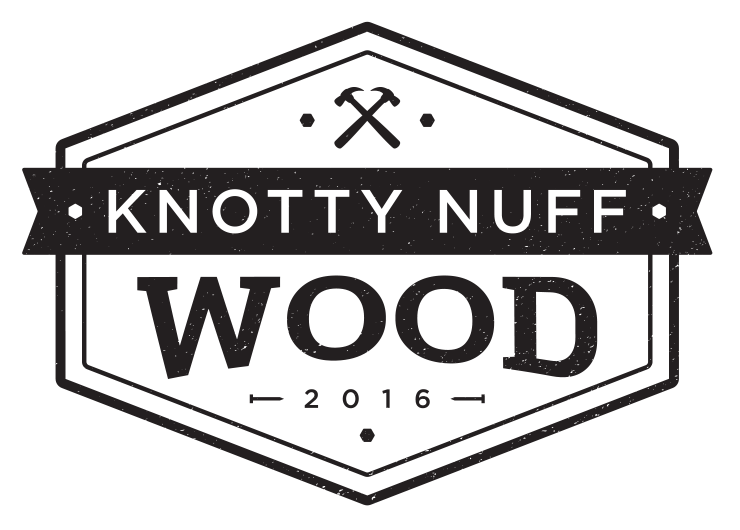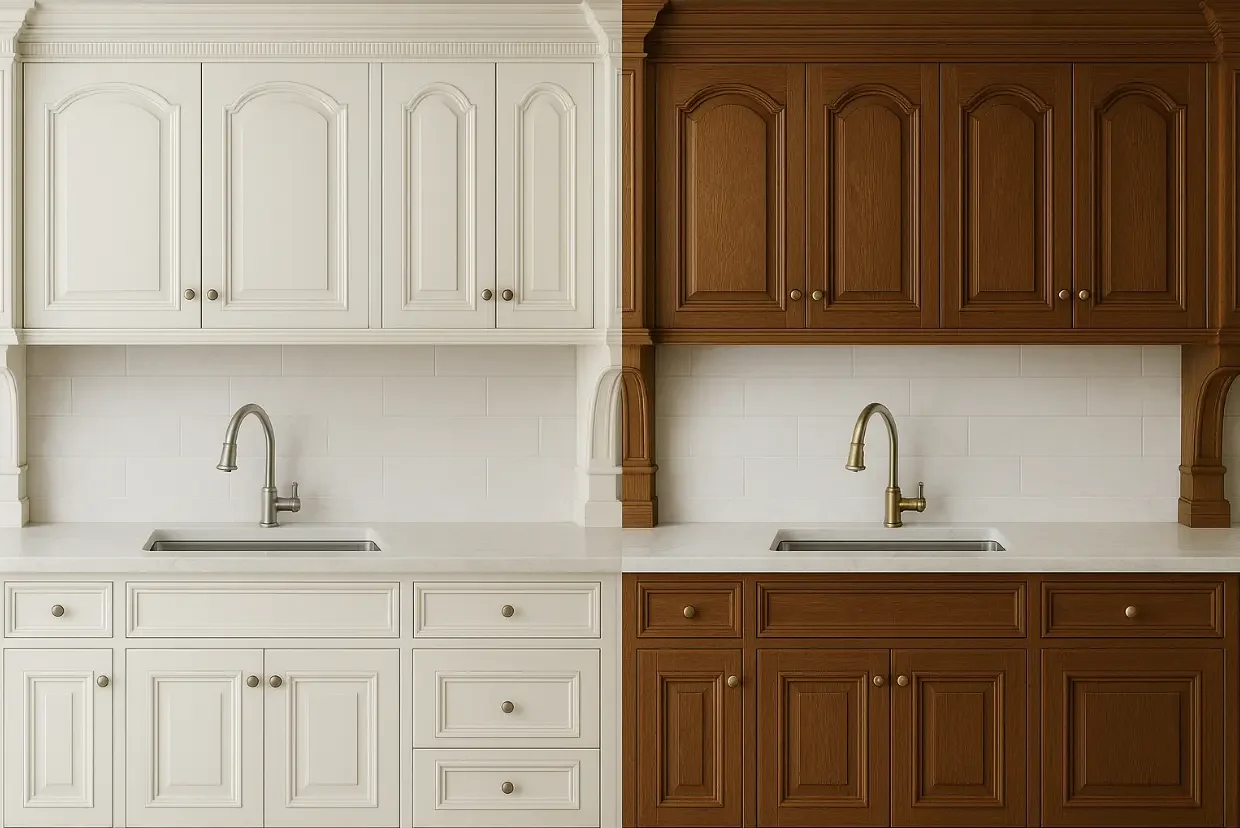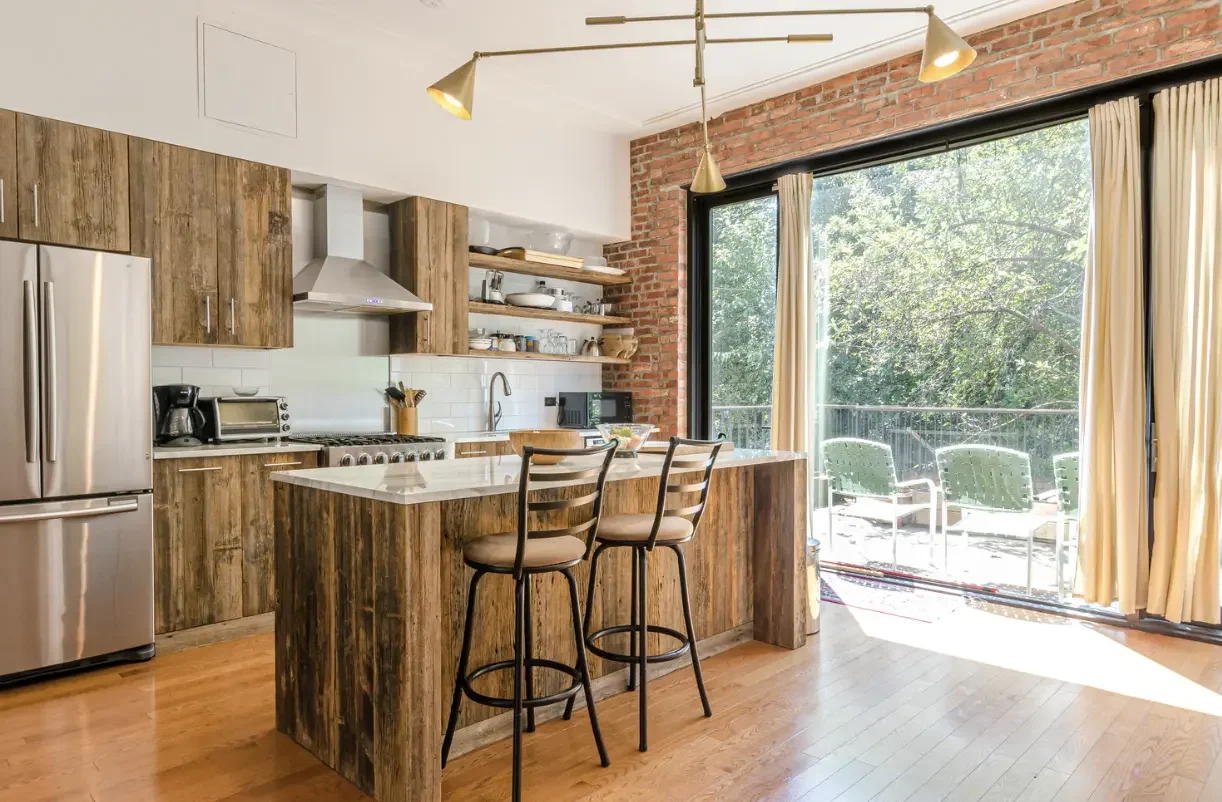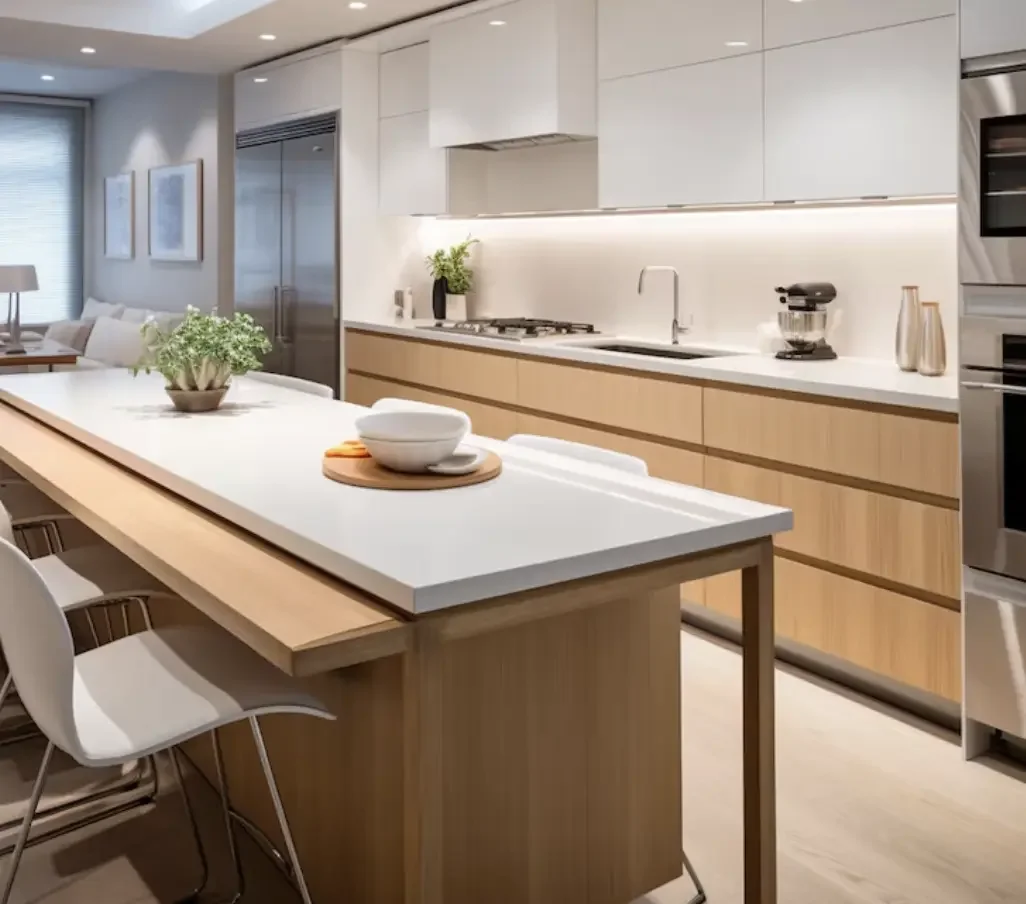At Knotty Nuff Wood, we know that choosing between light vs dark kitchen cabinets isn’t just a design question; it’s an investment in how you feel in your home or workspace every single day.
Whether you're a homeowner reimagining your dream kitchen or a business owner upgrading a restaurant, office, or retail space, your choice of cabinet color sets the tone for everything else. And let’s face it: no one wants to live or work in a kitchen that feels off.
This isn’t a light decision (pun intended). It’s personal. It’s functional. It’s aesthetic. And it can impact everything from mood and maintenance to resale value and branding.
In this ultimate comparison, we’ll cover everything you need to know, from lighting and size considerations to cleaning, resale, commercial use, and how to pair your cabinets with countertops, flooring, and appliances. You’ll also learn how handcrafted wood cabinets can amplify the pros of both light and dark designs.
What’s the Real Difference Between Light and Dark Kitchen Cabinets?
The terms "light" and "dark" go beyond just color. It’s about how the wood tone, finish, and light reflectivity shape your space and affect daily functionality.
Light kitchen cabinets typically range from whites and creams to pale grays, soft taupes, and natural blond woods like maple or birch.
Dark kitchen cabinets include rich shades like espresso, walnut, charcoal, navy, and even black.
The impact is visual and emotional: lighter cabinets tend to feel airy, open, and bright, while darker cabinets feel bold, grounded, and luxurious.
But that’s just the start.
How Light Affects Cabinet Color: Natural and Artificial Lighting Considerations
Before you fall in love with a cabinet color, look around your kitchen or the kitchen you're planning.
Ask yourself:
Does the space get plenty of natural light?
Are there windows, skylights, or reflective surfaces?
What kind of artificial lighting will you use, cool LEDs or warm incandescent?
Light Cabinets in Bright Kitchens
If your kitchen already has loads of sunlight, light cabinets will bounce that light around, making your space feel even more airy and expansive. This is ideal for:
Small residential kitchens
Cafés or bakeries wanting a bright, clean ambiance
Offices with open-concept breakrooms
Dark Cabinets in Dim Kitchens
On the flip side, dark cabinets can absorb light, sometimes too much. But with the right lighting plan (think under-cabinet LEDs or pendant lighting), dark cabinetry can create drama and elegance even in smaller or windowless kitchens.
This is especially powerful in:
Upscale restaurants and wine bars
Home kitchens with moody design goals
Luxury rental properties
How to Choose Based on Kitchen Size and Layout
Yes, size matters, especially in cabinetry color.
Small Kitchens: Why Light Cabinets Often Work Best
Lighter cabinets reflect more light and create the illusion of space, making them perfect for:
City apartments
Compact office kitchens
Studio spaces or ADUs
They help you avoid a closed-in feeling and often blend seamlessly with minimalist, Scandinavian, or coastal styles.
Large Kitchens: Why Dark Cabinets Can Shine
Got space to play with? Dark cabinets can anchor a large kitchen beautifully, giving it warmth, weight, and sophistication.
Ideal for:
Open floor plans in residential homes
Commercial kitchens with industrial accents
Modern farmhouse designs are looking to ground the space
But here’s the secret sauce: pairing dark cabinets with lighter counters and backsplash creates a stunning contrast without shrinking the room.
What’s Easier to Maintain: Light or Dark Kitchen Cabinets?
Let’s be honest: kitchens get messy.
So, what’s more forgiving?
Light Cabinets: Hide Dust, But Not Everything
Pros: Great at masking dust, minor scratches, and smudges.
Cons: They show grease splatters, coffee spills, and hand grime more easily, especially near handles.
If you're in a high-traffic space like a café or co-working kitchen, you’ll want a finish that’s wipeable and stain-resistant.
Dark Cabinets: Hide Stains, Show Dust
Pros: They disguise spills, grease, and food smudges surprisingly well.
Cons: They can make dust, fingerprints, and watermarks more noticeable.
Dark cabinets with a matte or textured finish (like handcrafted wood with a subtle grain) can minimize these issues.
At Knotty Nuff Wood, we often use a hand-rubbed finish that makes maintenance way easier without losing that luxurious feel.
Do Light or Dark Cabinets Add More Resale Value?
Kitchen cabinets can make or break a buyer’s first impression. Color, in particular, plays a subtle yet powerful role in how people perceive the space.
Light Cabinets Often Win for Broad Appeal
Most homebuyers associate lighter cabinetry with freshness, cleanliness, and flexibility. Light tones work well with a wide range of décor styles, from modern farmhouse to coastal minimalism.
If you’re remodeling with resale in mind, going light might be the safest choice. Homes with white or pale wood kitchens tend to photograph better, show brighter, and feel more “move-in ready” to potential buyers.
Dark Cabinets Can Attract the Right Kind of Buyer
Darker colors are bold and dramatic. They communicate luxury and intention. While they might not be for everyone, they speak volumes in the right context.
In high-end homes, rentals, or custom-designed spaces, dark wood cabinetry can be the wow factor. Especially when combined with thoughtful lighting, textured finishes, and quality hardware.
Which Works Best for Commercial Spaces: Light or Dark Cabinets?
In business settings, design isn’t just about looks; it’s about function, branding, and the message the space sends to employees and customers.
Why Light Cabinets Work Well for Most Businesses
Lighter cabinetry tends to create an open, energized atmosphere. It’s often used in wellness clinics, modern offices, and anywhere clean aesthetics are key.
They also reflect light more efficiently, which helps when working with fluorescent or LED setups. In shared kitchens or lunch areas, they keep things feeling bright and welcoming.
Where Dark Cabinets Make a Statement
Darker tones feel grounded and professional. They're ideal for upscale restaurants, law firms, boutique hotels, and high-end co-working spaces.
They can also mask wear and tear, which helps in high-traffic zones. The key is making sure the space gets enough light, natural or artificial, so it doesn’t feel too enclosed.
How to Style Light Kitchen Cabinets the Right Way
Light cabinets aren’t just neutral, they’re a blank canvas. The real beauty lies in what you pair with them.
Pairing Light Cabinets with the Right Countertops
Contrasting textures and materials elevate the look. Butcher block adds natural warmth. Marble or quartz with bold veining brings elegance. Concrete or terrazzo offers an industrial edge.
Backsplashes That Add Personality
A white kitchen doesn’t have to be boring. Go for Moroccan tiles, zellige, or even a full slab backsplash to add visual interest. Subway tiles work too, but switch up the pattern or grout color to keep it fresh.
Best Flooring Options
Light cabinets pop beautifully against darker flooring. Think warm walnut, smoked oak, or slate tile. But if you want a minimalist vibe, light wood or cement-look floors create a seamless flow.
Hardware Finishes That Stand Out
Matte black and brushed gold are both strong options. Chrome works too, but consider texture, knurled knobs, or mixed metals can turn a simple kitchen into a designer space.
Designing with Dark Cabinets: How to Avoid a Heavy Look
Dark cabinets are dramatic by nature. But if the rest of your kitchen doesn’t balance the tone, the space can feel smaller or overly intense.
Bright Countertops Bring Balance
Countertops in light tones, white, cream, and light gray, help offset the depth of dark cabinets. They create contrast, making the space feel more layered and interesting.
Wood counters also work, especially in rustic or industrial kitchens. Just make sure the wood tone complements the cabinet color instead of clashing with it.
Use Backsplash to Break Things Up
A light, glossy backsplash can reflect light back into the room. Glass, white tile, or even metal finishes are great choices. Want something earthy? Natural stone works beautifully with deep wood tones.
Flooring That Doesn’t Compete
Skip dark wood floors unless your kitchen is massive. Instead, choose mid-tone or light flooring to ground the space without overwhelming it. Wide planks or herringbone patterns can add a custom touch.
Don’t Skimp on Lighting
This is non-negotiable. Toe-kick LEDs, under-cabinet lighting, and well-placed pendants make a world of difference. Dark cabinetry craves good lighting to shine, literally.
Is Mixing Light and Dark Cabinets a Good Idea? What to Know About Two-Tone Kitchens
If you’ve ever found yourself stuck between light and dark options, here’s the good news: you don’t have to choose just one.
Two-tone kitchens, where upper and lower cabinets or island and wall units contrast, are rising in popularity. And it’s not just a trend. It’s a smart, flexible design move.
Why Two-Tone Works
It offers the best of both worlds. Light tones can open the space and keep it airy. Dark tones ground the design and add richness. When paired well, they create depth and visual interest that single-tone kitchens often lack.
For example:
White uppers + navy lowers = classic and nautical
Oak uppers + charcoal base cabinets = modern and moody
Cream perimeter cabinets + espresso island = warmth with contrast
This layered look also gives you more creative room with finishes, hardware, and countertops.
How to Make Light and Dark Cabinets Work Together Without Clashing
A successful two-tone kitchen relies on intentional balance. One color should act as the anchor, while the other lifts or lightens the space.
Use Color Placement Strategically
As a rule of thumb, keep the darker cabinets on the bottom and lighter ones on top. This keeps the kitchen feeling grounded but not heavy. It also mimics the natural way we perceive weight and lightness, heavier tones below, brighter tones above.
This layout is especially effective in smaller kitchens or rooms with low ceilings.
Repeat Colors in Other Elements
If you’re mixing cabinet tones, echo those hues in other parts of the kitchen:
Backsplash accents
Veins in your countertops
Bar stools or light fixtures
Hardware finishes
This repetition creates cohesion. It’s what makes the design feel purposeful, not random.
Can Custom Cabinets Help Light or Dark Kitchens Look Better?
Absolutely. Custom cabinetry takes your vision and builds it with precision. It eliminates the compromises that often come with pre-fabricated options.
Why Custom Matters for Both Light and Dark Styles
Dark cabinets especially benefit from tailored proportions, thoughtful spacing, and smart lighting integration. Without careful planning, they can overpower a space.
Light cabinets, on the other hand, need strong detailing and texture to avoid looking flat or sterile. Custom millwork adds dimension, even in subtle ways, like the bevel of a door or the grain of the wood.
And in two-tone kitchens? Custom work ensures the proportions and transitions between tones feel balanced, not abrupt.
Whether you’re going sleek and modern or warm and traditional, customized cabinetry brings harmony and flow.
So, Which One Is Right for You?
Choosing between light and dark kitchen cabinets isn’t just about what’s trendy. It’s about how you want your space to feel, how it should function, and how it fits into your lifestyle or brand.
Ask yourself:
How much natural light does the space get?
Is this a personal kitchen or a commercial space?
Do you want something timeless or bold?
Do you need flexibility for resale, or do you want a strong statement?
No matter which direction you lean, light, dark, or a smart mix of both, the most important thing is cohesion. Your cabinets should feel like they belong. Like they were designed for your space, not dropped into it.
Conclusion
Whether you prefer the clean, open look of light kitchen cabinets or the bold, elegant feel of dark kitchen cabinets, the right choice depends on your space, your lighting, and your personal style.
There’s no one-size-fits-all answer. Some kitchens benefit from the brightness of lighter tones, while others thrive with the depth and warmth of darker finishes. It all comes down to what feels right for your home or business.
If you’re planning a kitchen remodel or starting fresh with a new build, this is the perfect time to explore custom cabinetry. With the right design, layout, and finish, your cabinets can completely transform how your kitchen looks and works.
Want expert help bringing your ideas to life? Contact us at Knotty Nuff Wood to start your custom kitchen cabinet project, whether it’s residential or commercial, light or dark, simple or bold.



